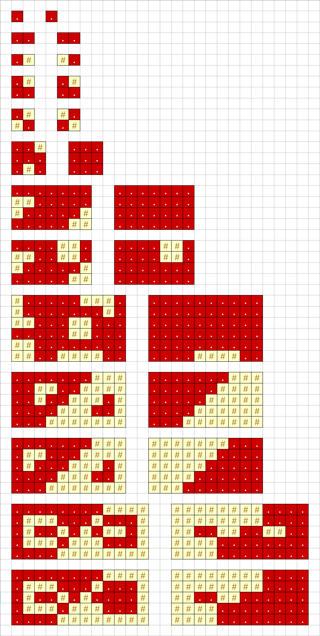Switch the colour of the largest non-unique connected shape
Given a rectangular grid of square cells, find the non-unique connected shapes with the largest area, and switch their colour
Input
- A rectangular grid of cells, each of which has 1 of 2 distinct values ("colours")
- You can choose to accept any of
- an image with only 2 distinct pixel colours
- text with only 2 distinct characters (also allowing newlines for forming a rectangle)
- a 2d array, with each element having 1 of 2 distinct values
- a 1d array, plus a width and/or height
The 2 distinct values will be referred to as "colours", but the rules apply similarly for all of the permitted formats
Output
- A rectangular grid of cells in the same format as the input, using the same 2 colours
- For each shape required to be changed, all of its cells have been switched to the other colour
Rules
- Each cell is part of a connected shape, which contains all cells of the same colour that can be reached by a path made up only of vertical or horizontal steps to adjacent cells of the same colour (no diagonal steps)
- The grid does not wrap: a shape cannot be connected across the outer boundary
- A shape is identical to another if it can be made to coincide exactly with it by any combination of
- translation
- rotation by an integer multiple of 90 degrees
- reflection in any vertical or horizontal line
- switching its colour
- A shape is unique if no other shape is identical to it
- The area of a shape is the number of cells it contains
- The shapes to be changed are those with the largest area, of those that are non-unique
- If 2 or more distinct shapes are non-unique and have the largest area, all instances of each distinct shape must be changed
- If there are no non-unique shapes, the output is the same as the input
- A grid (input or output) may sometimes contain only 1 of the 2 colours
Test cases
Each test case is an input followed by its unique correct output
. .
.. ..
.# #.
.# .#
.. ..
.# #.
#. .#
..# ...
... ...
.#. ...
....... .......
##..... .......
#.....# .......
.....## .......
....##. ....##.
##..##. ....##.
#.....# .......
.....## .......
#.....###. ..........
#.......#. ..........
##...##... ..........
.....##... ..........
##........ ..........
##..####.. ....####..
.......### .......###
..##..#### ......####
..#..###.# .....#####
....###..# ....######
...####### ...#######
.......### #######...
.##...#### ######....
.#...###.# #####.....
....###..# ####......
...####### ###.......
........#### ########....
.###...#...# ########....
.#..#.#.##.# ##..##..##..
.###.###...# ####........
....######## ####........
........#### ########....
.###...#...# ########....
.#..#.#....# ##..##......
.###.###...# ####........
....######## ####........
The same test cases with colour coding for human reading (click image for larger version):
Scoring
This is code-golf. Your score is the number of bytes in your source code. For each language, the code with the lowest score wins
Sandbox thoughts
- Any important/useful test cases welcome
- Is there a more useful format for 2d test cases?
- Are there 2 distinct characters that would make human reading easier?
- Is this a duplicate?
- Can anything be made clearer or more succinct?
- I'm also trying to think of a better name

